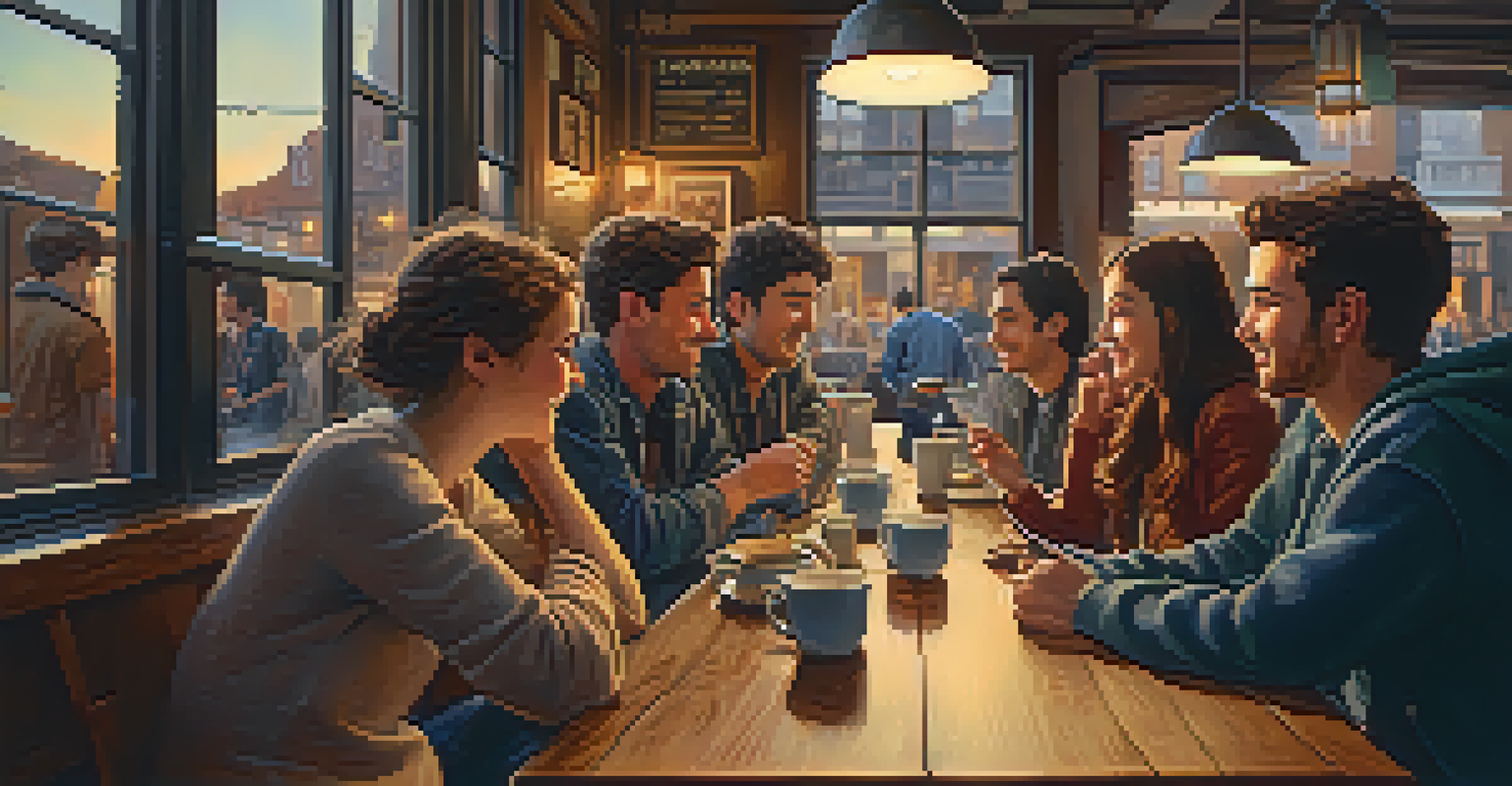Youth Culture in Film: How Hollywood Captures Generational Change

The Evolution of Youth Culture in Film
Youth culture has always been a reflection of societal changes, and film serves as a mirror to these shifts. From the rebellious antics of the 1950s in 'Rebel Without a Cause' to the digital dilemmas faced by today's youth in 'Eighth Grade,' cinema captures the essence of each generation. These films not only entertain but also provide insight into the values, struggles, and aspirations of young people across different eras.
Film is a reflection of the society in which it exists, and youth culture is a key aspect of that reflection.
As each decade passes, filmmakers draw from the zeitgeist of their time, weaving in elements that resonate with the youth. For instance, the rise of counterculture in the 1960s brought films like 'Easy Rider' to the forefront, showcasing the quest for freedom and identity. This evolution highlights how youth culture adapts to changing social landscapes while influencing mainstream narratives.
Ultimately, the portrayal of youth in films serves as a commentary on broader societal dynamics. By examining these cinematic representations, we can better understand how Hollywood not only reflects youth culture but also shapes it, creating a continuous dialogue between generations.
Iconic Films That Defined Generations
Certain films have become iconic symbols of youth culture, profoundly influencing the younger audience. Movies like 'The Breakfast Club' and 'Clueless' encapsulate the trials and tribulations of adolescence, becoming touchstones for their respective generations. These films resonate because they address universal themes of identity, friendship, and the search for belonging.

The characters in these films often represent diverse aspects of youth life, allowing viewers to see themselves reflected on screen. For example, 'The Breakfast Club' features a group of high school students from different backgrounds, each dealing with their own challenges. This representation fosters empathy and connection among viewers, bridging generational divides.
Youth Culture Reflects Society
Films serve as a mirror to societal changes, capturing the essence of each generation's values, struggles, and aspirations.
Moreover, these films often set trends in fashion, language, and social behavior, further solidifying their impact on youth culture. They become cultural touchstones, where quotes and styles from the films seep into everyday life, creating a lasting legacy that influences future generations.
The Rise of Digital Natives in Film
With the advent of technology, today's youth are often dubbed 'digital natives,' and films have begun to reflect this new reality. Movies like 'Social Network' and 'Ready Player One' explore themes of online identity and virtual escapism, resonating with a generation that has grown up with the internet. These narratives illustrate the complexities of living in an age where social media dictates much of youth culture.
The power of film lies in its ability to illuminate the lives of young people and the challenges they face.
This shift in storytelling is significant as it highlights the unique challenges faced by contemporary youth. Issues such as cyberbullying, digital addiction, and the quest for authenticity in a curated online world are central themes in many modern films. By addressing these topics, filmmakers provide a platform for discussion and awareness among young audiences.
Additionally, the representation of technology in youth-centric films often sparks conversations about its implications on social interactions and mental health. As these films continue to evolve, they reflect the changing landscape of youth culture, illustrating how intertwined technology and identity have become.
Diversity and Representation in Youth-Centric Films
In recent years, there has been a notable push for diversity and representation in films that focus on youth culture. This shift reflects a growing awareness of the importance of including different voices and stories in mainstream cinema. Films like 'Crazy Rich Asians' and 'Moonlight' showcase the rich tapestry of youth experiences, offering perspectives that were often marginalized in earlier narratives.
Diversity in film not only enriches storytelling but also allows young viewers from various backgrounds to see themselves represented on screen. This visibility fosters a sense of belonging and validation, encouraging young people to embrace their identities. As filmmakers strive for authenticity, the stories told today become more relatable and impactful.
Diversity Shapes Youth Narratives
Recent films emphasize diverse voices, allowing young viewers from various backgrounds to see themselves represented and fostering a sense of belonging.
Moreover, this emphasis on representation challenges stereotypes and broadens the narrative scope of youth culture. As audiences demand more inclusive stories, Hollywood is gradually reshaping its approach to storytelling, paving the way for a future where all youths can find their voice and stories reflected in film.
The Role of Music in Shaping Youth Culture in Film
Music has always played a pivotal role in youth-oriented films, often serving as a cultural backdrop that enhances the storytelling. From the catchy tunes of 'Grease' to the emotionally charged soundtracks of 'A Star is Born,' music helps define the eras portrayed in these films. It creates an atmosphere that resonates with the emotions and experiences of young audiences.
Moreover, the songs featured in films often become anthems for the youth, encapsulating their feelings and aspirations. For example, the soundtrack of 'The Breakfast Club' not only complements the film's themes but also solidifies it as a cultural phenomenon. These songs become part of the collective memory, influencing trends in music and lifestyle among young people.
As the relationship between film and music continues to evolve, we see a growing trend of integrating contemporary artists and genres into youth-centric narratives. This fusion not only keeps the storytelling relevant but also introduces new musical styles to younger audiences, further shaping their cultural landscape.
The Impact of Social Issues on Youth Films
Social issues have increasingly found their way into youth films, reflecting the concerns and realities of younger generations. Films like 'The Hate U Give' and '13 Reasons Why' tackle subjects like racism, mental health, and the pressures of social media, giving voice to the struggles faced by today's youth. This courageous storytelling not only raises awareness but also encourages dialogue around these important topics.
By addressing these social issues, filmmakers empower young viewers to engage with their communities and advocate for change. These narratives often resonate deeply, prompting discussions that can lead to increased understanding and solidarity among peers. As a result, youth films serve as catalysts for social awareness and activism.
Social Issues Drive Film Themes
Youth films increasingly tackle social issues like mental health and racism, empowering young audiences to engage in important societal dialogues.
Furthermore, the incorporation of these themes into mainstream cinema reflects a broader cultural shift towards empathy and understanding. As audiences become more attuned to these pressing issues, the demand for authentic storytelling in youth films will likely continue to grow, shaping the future of Hollywood and its representation of youth culture.
The Future of Youth Culture in Film
As we look towards the future, the landscape of youth culture in film is bound to evolve alongside societal changes. With the rise of streaming platforms and independent filmmaking, diverse voices are more accessible than ever. This shift opens up opportunities for fresh perspectives and innovative storytelling that resonate with younger audiences.
Moreover, as global connectivity increases, youth films will likely reflect a wider array of cultural experiences. The blending of global influences will create rich narratives that showcase the complexities of youth identity in an interconnected world. As filmmakers continue to push boundaries, we can expect to see more authentic and varied representations of youth culture.

In essence, the future of youth culture in film looks promising as it embraces diversity, technology, and social awareness. By capturing the essence of each generation, Hollywood will continue to play a crucial role in shaping how youth culture is perceived and understood, fostering a deeper connection between film and the youth it represents.